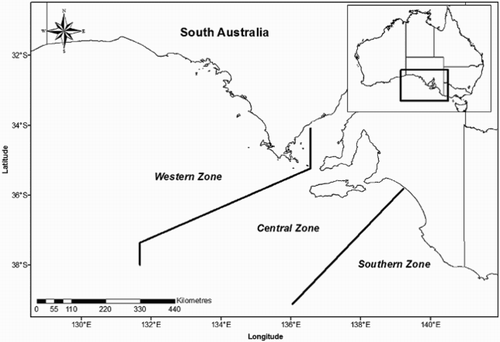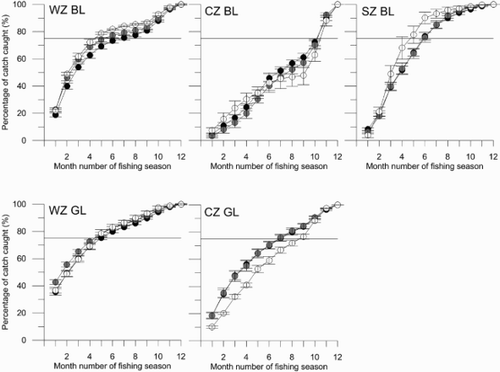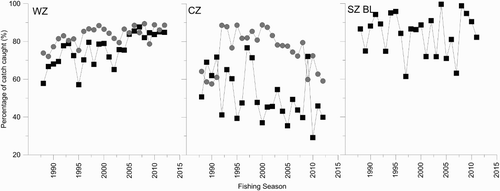ABSTRACT
Stock assessments of quota or effort managed fisheries in which the duration of the fishing season is 12 months are invariably delivered well into the subsequent fishing season. As a result, quotas are frequently based on year-old data. This delay is often unavoidable because it may take months to collect, collate and analyse data necessary to assess fishery performance. The South Australian fisheries for blacklip (Haliotis rubra Leach, 1814) and greenlip abalone (H. laevigata Donovan, 1808) have addressed this issue by using provisional data on current stock status to inform application of the harvest strategy decision rules that set the quota for the next year. The primary index of relative abundance for these fisheries is catch per unit effort (CPUE). Our study uses 25 years (1988–2012) of CPUE data to quantify the differences between the provisional and complete-season CPUE estimates at the spatial scales used to assess the fisheries. We demonstrate that, in most cases, there was a strong relationship between the provisional and complete-season CPUE estimates for both species, with little evidence of bias. As the provisional CPUE estimates were a reliable and accurate predictor of the complete-season CPUE estimates, this provides a high degree of confidence in using provisional CPUE estimates to set quotas, thereby overcoming the difficulty of basing decisions on aged data. These findings are likely to be applicable to other fisheries, particularly those where much of the annual catch is obtained (or effort expended) in a short time period at the commencement of the fishing season.
Introduction
Sustainable harvests—the primary target of fisheries management—fundamentally depend on an assessment of changes in the abundance and the exploitation rate of the target species and the subsequent development of appropriate management strategies. In quota/effort managed fisheries there is often no break between seasons, so it is common for decisions for the subsequent fishing season to be based on aged data (i.e. ≥12 months; e.g. Woodhams et al. Citation2012; Grubert et al. Citation2013). This is because the increasing spatial/temporal complexity of fisheries stock assessments (e.g. Lapointe et al. Citation2012; Grubert et al. Citation2013; Tarbath et al. Citation2014), especially those that are model based (e.g. Breen et al. Citation2003; Dunn & Hanchet Citation2010), often requires a long time period between the conclusion of one fishing period and delivery of stock status and scientific advice. Such lengthy delays between the end of a fishing season, the completion of the stock assessment and any subsequent management decisions can result in catch and/or effort levels that lag changes in stock abundance (Bax et al. Citation2003; Brown et al. Citation2012). Consequences of delayed fishery management include an increased probability of stock collapse and subsequent reduced productivity from excessive exploitation levels (Shertzer & Prager Citation2007) and the converse of failing to increase catch and/or effort in response to increased abundance, resulting in lost revenue (Smith Citation1993). For species that are short lived, of high value and/or have a high susceptibility to overfishing, delaying management action can represent either a significant risk, or lost opportunity.
This study demonstrates the effectiveness of using provisional (part-season) data to overcome these difficulties in the high-value, South Australian abalone fisheries (SAAFs). Divers have hand-harvested blacklip (Haliotis rubra Leach, 1814) and greenlip (Haliotis laevigata Donovan, 1808) abalone (hereafter termed blacklip and greenlip, respectively) since these fisheries began in 1964. In 2013/14, the South Australian total catch was 876 t shell weight (greenlip 45%; blacklip 55%) (South Australian Research and Development Institute [SARDI], unpubl. data). A similar tonnage in 2011/12 was valued at approximately AU$29 million (Paterson et al. Citation2013). The South Australian fishery is well described elsewhere (see Mayfield et al. Citation2011, Citation2013; PIRSA Citation2012). Briefly, the fishery is divided into three separate fishing zones () which were created in 1971: Western Zone (WZ), 22 licences harvesting 471.3 t shell weight (SW) in 2014 from 31 spatial assessment units (SAUs); Central Zone (CZ), six licences harvesting 167.4 t SW in 2014 from 11 SAUs; and Southern Zone (SZ), six licences harvesting 158.7 t SW in 2013/14 from 13 SAUs. Each zone has an annual fishing season (WZ and CZ: 1 January to 31 December; SZ: 1 September to 31 August). The zones are managed separately using input and output controls that include limited entry (maximum number of licences), species-specific minimum legal lengths, and a harvest strategy in a legislated management plan that drives annual total allowable commercial catch (TACC) decisions (PIRSA Citation2012). Minimum legal lengths (MLLs) vary among zones and between species (range 110–145 mm shell length).
Fisheries management has evolved since the realisation that the ocean’s resources are exhaustible. In recent years, harvest strategies have become the standard to aid management (Hillborn Citation2012), with their implementation now common (Caddy Citation2004; Smith et al. Citation2008), including in data-poor fisheries (Dowling et al. Citation2008). The harvest strategy for the SAAFs (PIRSA Citation2012) is species-specific, spatially explicit and comprises two key components. First, a series of performance indicators (PIs)—based on fishery-dependent and fishery-independent data—and reference points are used to categorise the risk of overfishing the stocks in each SAU, the spatial scale at which the stock assessment occurs. This formal assessment is applied only to those SAUs that are the most important, by catch (i.e. high and medium importance), to each fishery; low importance SAUs are not assessed. The risk of overfishing for each SAU is provided in the stock assessment reports that are usually produced within 10 months from the end of the fishing season (e.g. Mayfield et al. Citation2013; Stobart et al. Citation2014b). One of the primary fishery-dependent PIs is catch per unit effort (CPUE). Despite the possible difficulties with using CPUE as an index of relative abundance (Leporati et al. Citation2009), particularly in dive fisheries (e.g. Shepherd & Rodda Citation2001; Burch et al. Citation2010), it remains a primary indicator of stock abundance for the SAAF. This is because CPUE: (1) is readily available across the entire fishery at the fine spatial scale at which assessment is made; (2) is a less costly measure than alternatives such as fishery-independent surveys (Maunder & Punt Citation2004; Cotter & Pilling Citation2007); and (3) yields a useful measure of stock status because measurement of CPUE at a fine spatial scale across the fishery provides meaningful indications on stock abundance, particularly when assessed in context with other data (Dowling et al. Citation2008; Smith et al. Citation2009; Tarbath et al. Citation2014).
Second, each risk of overfishing category has prescribed management decision rules that are applied to each SAU to determine the TACC for the next fishing season. This is done approximately 3 months before the conclusion of the current fishing season. CPUE estimates from the first 7 months of the current fishing season (hereafter termed ‘year to date’ [YTD]), provide more recent data for comparison with the historical time series and are used to inform application of the harvest decision rules during TACC discussions. The importance of YTD data to the management agency and fishers has increased substantially since the promulgation of the harvest strategy for the SAAFs (PIRSA Citation2012) and an increasing trend for proactive, rather than reactive, management. Proactive application of the decision rules (i.e. percentage increase or decrease of the catch contribution) relies heavily on the YTD data as the harvest decision rules include an element of plasticity. For example, a SAU assigned to the green risk of overfishing category is subject to the harvest decision rule of ‘10% reduction to 10% increase’ and YTD CPUE estimates can be used to inform the appropriate catch contribution. Ultimately, these YTD data can influence the outcome of the harvest strategy and thus subsequent TACCs.
The aim of this study was to determine the reliability, accuracy and potential bias of the CPUE YTD estimates as predictors of the complete-season CPUE estimates to validate their current and potential use in the quota setting process in the SAAFs. In particular, we seek to determine whether YTD data could be used to deliver stock assessment reports for the SAAF, and in the application of the harvest strategy. To do this, we examine relationships between YTD and complete-season CPUE estimates for both species in most SAUs. In addition, as relative levels of catch harvested (% of TACC) and fishing effort (days) expended can influence the strength of these relationships among fisheries, we also evaluate their influence on CPUE estimates when using YTD data.
Strong relationships between the YTD and complete-season CPUE estimates were identified, yielding a high level of confidence in the use of YTD data. Therefore, this approach is likely to be of value to other fisheries, because it offers the opportunity to set TACCs/effort levels with more recent data, particularly those where much of the annual catch is obtained (or effort expended) in a short time period at the commencement of the fishing season.
Materials and methods
Data sources
This study focuses on five of the six abalone fisheries in South Australia: WZ greenlip, WZ blacklip, CZ greenlip, CZ blacklip and SZ blacklip. The SZ greenlip fishery was excluded because the CPUE on greenlip in SZ cannot be estimated as greenlip comprise <5% of the total catch. Data from 1 January 1988 to 31 December 2012 (i.e. 25 years) were used, sourced from catch and effort information provided to SARDI by abalone fishers as part of their licence conditions. These data include fishing date and location, dive time (i.e. fishing effort; hours [h]) and weight of greenlip and blacklip catch in kilograms (kg).
The catch and effort data set was filtered to remove outliers using the methods described in Burch et al. (Citation2011) and applied in annual stock assessments for these zones and species (see Mayfield et al. Citation2013, Citation2014; Stobart et al. Citation2014a, Citation2014b). For WZ and CZ, records were omitted: (1) that had an unrealistically high total daily catch (>900 kg SW); (2) that represented either an incomplete fishing day (fishing effort <3 h) or an unreasonably high level of diving time (>8 h); or (3) where total catch/fishing effort was >150 kg h−1 (SW). These records were excluded from the analysis. For SZ, where diving occurs in shallower water and daily catches are typically higher than those in CZ and WZ, the catch and effort criteria for records to be omitted was slightly different (total daily catch: >1200 kg SW; fishing effort >10 h). Overall, the omitted records reduced the data set by <1% (see Burch et al. Citation2011).
CPUE estimation
CPUE was estimated for each of the five fisheries and by species for the high (n = 15) and medium (n = 24) importance SAUs, by cumulative month, for all 25 years, using the catch-weighted mean of daily CPUE (Burch et al. Citation2011) which is consistent with current assessments of these fisheries (Mayfield et al. Citation2013, Citation2014; Stobart et al. Citation2014a, Citation2014b). CPUE is only estimated where there are at least 10 daily records and the catch of the species for which CPUE is being estimated constitutes ≥30% of the total combined daily catch. This allows for the fact that both blacklip and greenlip can be harvested on the same fishing day and fishing effort is not apportioned between these (Burch et al. Citation2011). For each of the five fisheries, the accumulated catch and number of daily fishing records used to estimate CPUE, and the cumulative estimate of CPUE was determined for each successive fishing day for each of the 25 years from 1988 to 2012 for CZ and WZ fisheries and 24 years from 1988 to 2011 for the SZ blacklip fishery.
Relationships among CPUE estimates
Relationships between estimates of YTD (i.e. first 7 months of the 12-month fishing season; denoted CPUEYTD) and complete-season (i.e. all 12 months; denoted CPUEFINAL) CPUE estimates were evaluated using scatter plots and tested for significance using Pearson’s correlation, following confirmation that the underlying assumptions were met. The relationship between successive complete-season CPUEs (CPUEFINAL vs CPUEFINAL−1) were similarly evaluated (but no figure was presented here for efficiency). The mean absolute differences between cumulative monthly CPUE and CPUEFINAL estimates from 1988 to 2012 were also determined for each fishery and SAU. These analyses were done to quantify differences in monthly CPUE estimates from CPUEFINAL between species and among SAUs and fisheries. The annual differences in CPUEYTD and CPUEFINAL (CPUEYTD – CPUEFINAL) from 1988 to 2012 were calculated for each fishery and for the high and medium importance SAUs to identify and quantify bias across years. Where the difference between CPUEYTD and CPUEFINAL was <5% the provisional estimate was considered to be acceptable because the coefficients of variation in this fishery seldom exceed 5%.
Relationships among catch, effort and CPUE difference
Cumulative catch and effort were evaluated to determine their contribution to the strength of the relationships between CPUEYTD and CPUEFINAL. First, the total catch was determined for each of the five fisheries, by cumulative month, for all 25 years. From the resultant data, monthly estimates of the percentage of the TACC harvested were calculated for: (1) all 25 years; (2) the last 15 years (i.e. 1998–2012); and (3) the last 5 years (i.e. 2008–2012). The annual proportion of the TACC harvested by the end of the seventh month of the fishing season was similarly obtained.
Results
There were almost universally strong relationships between the estimates of CPUEYTD and CPUEFINAL (). These relationships were strongest for the WZ greenlip, WZ blacklip, CZ greenlip and SZ blacklip fisheries (r value range: 0.671–0.988; all P ≤ 0.01) and for several of the high-importance SAUs that have been intensively fished over an extended time period (e.g. greenlip at The Gap, Point Avoid and Tiparra Reef; blacklip at Ward Island, Hotspot, Gerloffs Bay and Middle Point; r value range: 0.949–0.994; P ≤ 0.01). Relationships between estimates of CPUEYTD and CPUEFINAL were also significant (P ≤ 0.01) for the medium-importance SAUs (e.g. greenlip at Hotspot, Flinders Island and Taylor Island, blacklip at Anxious Bay and Carpenters Rocks (; r value range: 0.972–0.994; P ≤ 0.01). In contrast, for the CZ blacklip fishery and for blacklip in the West Kangaroo Island SAU, CPUEYTD was a weaker predictor of CPUEFINAL (; r = 0.671 and 0.669, respectively). In contrast, relationships between CPUEFINAL and CPUEFINAL−1 were, predictably, more variable with typically lower r values (r value range: 0.11–0.914).
Figure 2. Scatterplots of CPUEFINAL against CPUEYTD (kg h−1) from for WZ, CZ and SZ and for high- and medium-importance SAUs from 1988–2012 for WZ and CZ, and 1988–2011 for the SZ. BL, blacklip (![]()
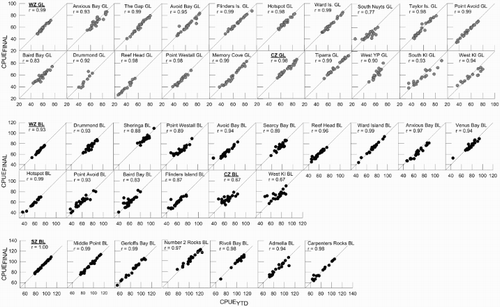
The difference between cumulative monthly estimates of CPUE and CPUEFINAL generally reduced sequentially across the annual fishing season at all spatial scales considered (). However, the magnitude and rate of reduction in this difference varied between species, among fisheries and SAUs. Across the five fisheries, the difference between the estimates of CPUE at the end of the first fishing month and the end of the year ranged between 6% (WZ greenlip) and 13% (WZ blacklip) (A). During the fishing season, these differences reduced rapidly for four of the five fisheries. Notably, the difference between the cumulative monthly estimates of CPUE and estimates of CPUEFINAL were <5% in the WZ greenlip, WZ blacklip, CZ greenlip and SZ blacklip fisheries by the end of the fourth month of the fishing season. Similar temporal trends were evident for some of the high-importance SAUs considered (e.g. blacklip at Middle Point, Gerloffs Bay and Sheringa; greenlip at The Gap) (B, D). In contrast, for CZ blacklip, the differences between the cumulative monthly estimates of CPUE and CPUEFINAL exceeded 5% until the completion of the eleventh month of the fishing season (C).
Figure 3. CPUE absolute percentage difference by month (±SEM) for zone-wide and selected SAUs compared with complete-season values for: A, entire fisheries; B, high-importance SAUs from WZ blacklip and greenlip; C, high-importance SAUs from CZ blacklip and greenlip from 1988–2012; and D, high-importance SAUs from SZ blacklip from 1988–2011. Reference line is at 5% CPUE difference. BL, blacklip; GL, greenlip; Is, Island; KI, Kangaroo Island.
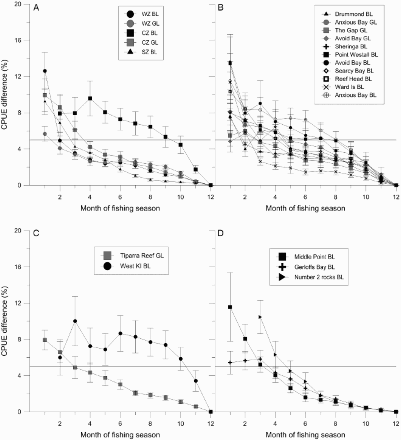
Despite the different temporal patterns in the rate and magnitude of the cumulative monthly estimates of CPUE and CPUEFINAL, by month seven the percentage differences between CPUEYTD and CPUEFINAL estimates were generally similar across fisheries, SAUs and species (). The median difference ranged from 0.56% for greenlip in the West Yorke Peninsula SAU to 7.5% for greenlip in the South Kangaroo Island SAU. Although there was inter-annual variability across the 25-year period, in many cases the interquartile range was narrow (<5%) and the upper bound of the interquartile range was within 5% of CPUEFINAL. The obvious exceptions for greenlip were Anxious Bay, South Nuyts Archipelago, Drummond, Memory Cove, West Yorke Peninsula, South Kangaroo Island and West Kangaroo Island SAUs. While for blacklip, the exceptions were the CZ blacklip fishery, Point Westall, Searcy Bay, Anxious Bay, Point Avoid, Venus Bay and Baird Bay and West Kangaroo Island SAUs. For these examples, the interquartile range was large (up to 15%) and both the upper bound of the interquartile range and the median deviation value generally exceeded 5% of the CPUEFINAL estimate ().
Figure 4. Box and whisker plot of absolute CPUE difference between year-to-date CPUE and complete-season CPUE values for entire zone and for all high- and medium-importance SAUs from WZ and CZ and selected SAUs from SZ for: A, greenlip; and B, blacklip WZ (1988–2012), CZ (1988–2012) and SZ (1988–2011). Boxes contain data between 25th and 75th quartiles with median marked by horizontal black line. Whiskers represent 5th and 95th percentiles. Reference line is at 5% CPUE difference. Is, Island; YP, Yorke Peninsula; KI, Kangaroo Island.
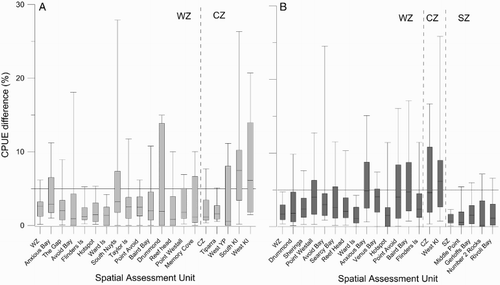
The direction and magnitude of the difference between CPUEYTD and CPUEFINAL varied spatially and temporally over the 25-year data range (). These differences were mostly not consistent (e.g. CZ blacklip fishery, blacklip in the West Kangaroo Island SAU and greenlip in the Anxious Bay SAU) as there are few areas where CPUEYTD estimates consistently over- or underestimated CPUEFINAL (i.e. systematically biased). The only fisheries exhibiting bias (>80% of the time) were greenlip in WZ (mean positive bias: 2.9%) and blacklip in WZ (mean positive bias: 2.4%) and SZ (mean positive bias: 1.2%). In these three fisheries, the estimate of CPUEYTD was, with rare exception (<20% of the time), higher than CPUEFINAL (i.e. positively biased). The only SAU with reasonable levels of consistency among years was blacklip in the Anxious Bay SAU where in 96% of the years examined, CPUEYTD overestimated CPUEFINAL (mean positive bias: 6.2%). For the CZ blacklip and greenlip fisheries and remaining SAUs, no consistent temporal trends in over- or underestimating CPUEYTD were evident. However, for several SAUs, recent (last 5 years) differences between CPUEYTD and CPUEFINAL were lower than those observed earlier in the data time series (blacklip: Anxious Bay, Point Westall and Drummond; greenlip: Avoid Bay, The Gap and Anxious Bay SAUs).
Figure 5. CPUE percentage difference between year-to-date CPUE and complete-season CPUE values for: A, WZ blacklip, CZ blacklip, SZ blacklip, WZ greenlip and CZ greenlip fisheries; B, high-importance SAUs from each fishery: Drummond blacklip, Sheringa blacklip, Pt Westall blacklip, Avoid Bay blacklip, Searcy Bay blacklip, Reef Head blacklip, Ward Island blacklip, Anxious Bay blacklip, Anxious Bay greenlip, The Gap greenlip, Avoid Bay greenlip, Tiparra Reef greenlip, West KI blacklip, Middle Point blacklip, Gerloffs Bay blacklip and Number 2 Rocks blacklip SAUs from 1988–2012 for WZ and CZ fisheries and SAUs, and SZ blacklip and SAUs from 1988–2011. BL, blacklip; GL, greenlip; SAU, spatial assessment unit; PT, Point; KI, Kangaroo Island. *no data available.

Increasing catch and effort yielded CPUE estimates that were generally more similar to CPUEFINAL (). Across the five fisheries, the greatest variations among years in the difference between CPUEYTD and CPUEFINAL were evident in the CZ greenlip, CZ blacklip and WZ blacklip fisheries. Initial estimates of CPUE were generally smaller and larger than CPUEFINAL for WZ blacklip and CZ greenlip fisheries, respectively, while the CZ blacklip fishery exhibited no interannual consistency. This variation was reflected in: (1) the proportion of the TACC that needed to be harvested; and (2) the number of fishing days needing to be undertaken prior to the cumulative CPUE being within 5% of CPUEFINAL. For 20 of the 25 years of data used in this study (i.e. 80%; TACC range: 50% for SZ blacklip to 80% for CZ greenlip and blacklip; fishing days range: 74 days for CZ blacklip to 463 days for WZ blacklip). The variability in the number of fishing days among zones also reflects differences in the magnitude of the TACCs, the number of divers and the level of heterogeneity among fishing grounds.
Figure 6. Part of season CPUE % difference compared with complete-season CPUE values for WZ greenlip, WZ blacklip, SZ blacklip, CZ greenlip and CZ blacklip against the number of harvest strategy qualifying records and the proportion of catch. Vertical lines represent the point in the fishing season at which the CPUE difference was consistently below 5% for 20 of the 25 years (80%) for WZ and CZ, and 19 of the 24 years (79%) for SZ. BL, blacklip; GL, greenlip.
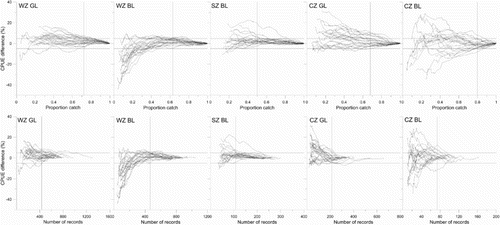
Over the 25-year period of this study, the TACCs have been harvested rapidly, with catches typically reaching ∼ 75% of the TACC by the end of the seventh month of the fishing season (). The only exception was the CZ blacklip fishery where catches reached only ∼ 50% of the TACC harvested by the end of seventh month. The proportion of the TACC harvested by the end of the seventh month varies considerably between species, year and zone (). The highest interannual variations were evident in the SZ and CZ blacklip fisheries. In contrast, catches from both of the WZ fisheries have been consistently high at the same point in time. Notably, the CZ greenlip and blacklip fisheries had the lowest proportion of TACC harvested at the end of the seventh month, with those over the most recent 5-year period the lowest recorded.
Discussion
In fisheries management, there is often a trade-off between making a decision in a timely manner and having sufficient confidence from the available data to make well-informed decisions and implement change. Our analysis of 25 years of historical data in this study on the SAAFs demonstrates for both species that CPUEYTD is commonly a reliable and accurate predictor of CPUEFINAL. This is an important finding because the need to delay management action can be avoided for these high-value species that have a demonstrated high susceptibility to overfishing and stock collapse (e.g. Prince Citation2004; Mayfield et al. Citation2012). More broadly, our analyses show that in fisheries where a large proportion of the catch or effort is concentrated at the beginning of a fishing season, provisional CPUE data can provide a suitable proxy for full season catch and effort data.
The degree to which CPUEYTD was able to predict CPUEFINAL varied between species and among fisheries and SAUs. Relationships between CPUEYTD and CPUEFINAL were strongest for the WZ and SZ fisheries and weakest for those in CZ (); overall, CPUEYTD was within 5% of CPUEFINAL for all the SAAFs examined with the exception of the CZ blacklip fishery (). For the component SAUs, the percentage difference between CPUEYTD and CPUEFINAL did not decline to less than 5% until later in the fishing season when compared with entire fisheries. This was an expected outcome, given the greater number of fishing days, and thus catch rate data, contributing to the fishery-wide estimates of CPUE, relative to individual SAUs. Despite there being fewer fishing records available for SAUs, CPUEYTD was within 5% of CPUEFINAL in the majority of cases examined, including all of the high-importance SAUs in SZ, all high-importance greenlip SAUs in WZ, five of the eight (62%) high-importance blacklip SAUs and for the only high-importance greenlip SAU in CZ. The key exceptions were principally for blacklip and included the West Kangaroo Island SAU in CZ and the Anxious Bay, Point Westall and Avoid Bay SAUs in WZ. Importantly, for blacklip at Anxious Bay, Point Westall and Drummond, and for greenlip at Avoid Bay, The Gap and Anxious Bay SAUs, recent (last 5 years) differences between CPUEYTD and CPUEFINAL were lower than those observed earlier in the data time series.
Differences in the strength of relationships between CPUEYTD and CPUEFINAL among fisheries and SAUs appear to be directly related to within-season fishing patterns. The timing of harvest within the fishing seasons was a key driver because, in fisheries where the majority of the catch is harvested early in the fishing season, estimates of CPUEYTD were more representative of CPUEFINAL as these were obtained from a larger proportion of the TACC. For example, in the WZ and SZ blacklip fisheries and the WZ and CZ greenlip fisheries, at least 75% of the TACC has typically been harvested by the end of the seventh month () yielding close agreement between CPUEYTD and CPUEFINAL. In contrast, the CZ blacklip fishery catches are typically taken later in the fishing season, resulting in the 25 yr mean proportion of the TACC at the end the seventh month being substantially lower at approximately 50%. In this fishery, there was clearly less similarity between the estimates of CPUEYTD and CPUEFINAL. It is likely that other factors including the magnitude of the TACCs, number of divers, number of fishing days, geographical expanse of each fishery and the degree of heterogeneity among fishing grounds (e.g. low in SZ, high in WZ) are also contributing to the strength of these relationships. However, quantifying the potential impact of these factors was beyond the scope of this study.
There was little evidence of consistent bias in CPUEYTD. The few exceptions were the WZ and SZ fisheries and blacklip in the Anxious Bay SAU where the estimates of CPUEYTD were consistently greater than CPUEFINAL, indicating positive bias. The most likely reason that CPUEYTD exceeds CPUEFINAL is the reduced abundance of legal-sized abalone later in the season following fishing. In these areas with consistent positive bias, a correction factor specific to each SAU should be applied to adjust CPUEYTD to increase the degree to which it reflects CPUEFINAL. While there are several ways in which corrective factors could be determined, one simple approach would be to compute the mean positive difference between CPUEYTD and CPUEFINAL and apply this to the CPUEYTD estimate. If this method were applied here, the correction factors would range between −1.2% (SZ blacklip fishery) and −6.2% (blacklip in the Anxious Bay SAU). For remaining zones and SAUs, bias was not consistent among years and thus the use of a correction factor would not be appropriate. However, even in absence of correction, estimates of CPUEYTD remain useful because they seldom vary by more than 5% from CPUEFINAL (except for CZ blacklip fishery and the West Kangaroo Island SAU). In addition: (1) the magnitude of the difference between CPUEYTD and CPUEFINAL in many SAUs has reduced through time (e.g. blacklip in the Drummond, Searcy Bay, Reef Head and Avoid Bay SAUs); and (2) the CPUEYTD estimates provide much better information about current relative abundance and are a better predictor of CPUEFINAL than the previous season’s CPUE (i.e. CPUEFINAL−1) (SARDI, unpubl. data).
The ability to make appropriate, confident and timely decisions, such that catch/effort levels in the fishery are more closely linked to stock abundance (Csirke Citation1984), can assist in avoiding the significant consequences of low and/or declining revenue from overfishing (Shertzer & Prager Citation2007) or a lost opportunity for increasing revenue (Smith Citation1993). Our study demonstrates that the CPUEYTD estimates are sufficiently reliable for application to setting the majority of the TACCs in the SAAFs, notably for both species in WZ, blacklip in SZ and for greenlip in CZ. The level of confidence in the CPUEYTD estimates has also been demonstrated by recent TACC reductions for greenlip and blacklip in WZ and blacklip in SZ. These TACC reductions did not arise from application of the harvest strategy, reflecting a lagged response to declining catch rates. Rather, they were proposed by the commercial sector because the provisional data (i.e. declining CPUE) was well matched to their recent fishing experiences (i.e. reduced stock abundance). While the commercial sector was free to propose such changes in the absence of the CPUEYTD data, these data added significant credibility to their position.
The direct use of CPUEYTD data by the commercial sector that endorse the findings of this study are timely because the harvest strategy is currently being reviewed. There are three potential mechanisms by which these data could be used to improve management decision making in these fisheries. First, the CPUEYTD estimates should be used to drive, rather than simply inform, application of the harvest decision rules for each SAU. This would reflect the demonstrated robustness of CPUEYTD and should be implemented through more explicit decision rules. Second, the CPUEYTD estimates should be used in the harvest strategy to categorise the risk of overfishing in SAUs based on the current fishing season, against which the decision rules would then apply. While this would ensure that a more current index of stock abundance is used to underpin the next year’s quota determination, increasing the currency of the remaining PIs also needs to occur to avoid increasing the weighting on CPUE in the assessment. Third, TACC setting in these fisheries should occur earlier in the current fishing season. Although TACCs have typically been set 2–3 months prior to the beginning of the fishing season, our analysis suggests TACC setting in these fisheries could, in many cases, occur earlier. Undertaking the process in a more timely manner would provide additional time for any difficult TACC deliberations and allow divers, licence holders and processors to develop their marketing and financial strategies for the subsequent fishing season.
Determining the point in the current fishing season when estimates of CPUEYTD become sufficiently accurate and reliable to inform management decisions depends on the criteria applied. One criterion could be the point at which the upper 95% confidence interval for CPUEYTD (i.e. CPUEYTD + standard error) has historically been within 5% of CPUEFINAL. For the two WZ fisheries, this point was reached at the end of the third month of fishing and was achieved a month later in the CZ greenlip and SZ blacklip fisheries. Alternatively, the number of completed fishing days could provide a reasonable proxy for the reliability of CPUEYTD, as indicated in , which yields similar outcomes to those above when converted to month. While this demonstrates that TACC setting could reliably occur earlier in the fishing season, changing the timing is dependent on consistency in fishing patters—both temporally and spatially—across years. We note a recent shift to harvesting greenlip (but not blacklip) later in the fishing season in WZ, reflective of demonstrable improvements in the yield from individual greenlip during autumn (Stobart et al. Citation2013). While targeting the harvest of greenlip into autumn still ensures adequate data for reliable estimation of CPUEYTD, the CPUE is likely to need standardising to account for the higher catch rates during this period. While catch (as a % of TACC) was also considered as an alternative criterion, application is difficult as it could only be utilised at the spatial scale of fisheries because SAU catch caps do not exist, preventing calculation of proportion TACC for SAUs. Given that the SAAFs are assessed at the spatial scale of SAUs, this criterion was considered unsuitable. The reliability of CPUEYTD estimates could also be impacted by changes in management arrangements such as the length and/or start date of the fishing season, TACC levels, abnormal weather patterns and diver behaviour in response to market demands and stock abundance (Gorfine & Dixon Citation2001; Stobart et al. Citation2013, Citation2014b; Mayfield et al. Citation2014). Consequently, periodic re-evaluation of the relationship between CPUEYTD and CPUEFINAL would be prudent, especially following any substantive changes to the fishery or stocks.
For blacklip in CZ, CPUEYTD was a relatively poor predictor of CPUEFINAL and there was a high degree of interannual variation in the differences between CPUEYTD and CPUEFINAL for blacklip in both CZ and the West Kangaroo Island SAU. This is in strong contrast to the other SAAFs, and suggests that the use of CPUEYTD estimates in the CZ fishery is problematic and potentially misleading. There are several potential solutions to this problem. These include:
accepting a larger percentage difference between CPUEYTD and CPUEFINAL for this fishery (e.g. 10%);
changing the fishing season, either by implementing a temporal closure to force fishing to be completed within a timeframe to allow the current season’s data to be used, or by changing the start and end date to match those of SZ (1 September to 31 August). Under the scenario of aligning the season’s start date with SZ, assuming that future monthly catches would be similar to those historically, ∼ 80% of the TACC would be taken in the first seven months of the fishing season, which would yield more reliable estimates of CPUEFINAL from CPUEYTD for this fishery; and
commencing the subsequent season with a provisional and small TACC, enabling the CPUEFINAL estimate from the previous fishing to drive the revised TACC.
As changing the season or issuing a provisional TACC would both require amending the regulatory and legislative framework for the fishery, the most tractable short-term option would be to avoid the use of provisional data in this fishery while the other potential changes are considered. Although it is clear that management decisions for the entire CZ blacklip fishery based on YTD data should be avoided, some of the other fisheries also contain SAUs where YTD CPUE estimates exceed our suggested 5% ‘limit’ for CPUE difference from CPUEFINAL. In these cases, the YTD data should be used cautiously, with the potentially higher levels of uncertainty in the CPUEFINAL estimates explicitly acknowledged.
In conclusion, this study has demonstrated the broad suitability of provisional CPUE estimates for informing TACC decisions for the subsequent fishing season in the SAAFs. The robustness of these data was underpinned by the generally strong relationships between CPUEYTD and CPUEFINAL. This close alignment between the provisional yearly value for each fishery and the subsequent annual estimate provides a high degree of confidence for decision making, avoids the need to delay management action for these highly valued stocks, and should be adopted in the revised harvest strategy. Our findings on the suitability of provisional data for fishery management are also likely to be of value to other fisheries, particularly for those where catches are harvested (or effort expended) over a short time period at the commencement of the fishing season.
Acknowledgements
We thank divers and licence holders for the provision of catch and effort data. Advice from two anonymous reviewers and Dr Rowan Chick substantially improved this manuscript.
Associate Editor: Associate Professor Andrea C Alfaro.
Disclosure statement
No potential conflict of interest was reported by the authors.
ORCiD
J Dent http://orcid.org/0000-0002-9662-8155
B Stobart http://orcid.org/0000-0001-8997-8934
J Carroll http://orcid.org/0000-0002-1404-5264
Additional information
Funding
References
- Bax NJ, Tilzey R, Lyle J, Wayte SE, Kloser RJ, Smith ADM. 2003. Providing management advice for deep-sea fisheries: lessons learned from Austrailia’s orange roughy fisheries. In: Shotton R, editor. Deep sea. 2003: conference on the governance and management of deep-sea fisheries. Queenstown, New Zealand: Food and Agriculture Organization of United Nations; p. 259–272.
- Breen PA, Kim SW, Andrew NL. 2003. A length-based Bayesian stock assessment model for the New Zealand abalone Haliotis iris. Mar Freshw Res. 54:619–634. doi: 10.1071/MF02174
- Brown CJ, Fulton EA, Possingham HP, Richardson AJ. 2012. How long can fisheries delay action in response to ecosystem and climate change? Ecol Soc Am. 22:298–310.
- Burch P, Mayfield S, Chick RC. 2010. A fisher-based, catch-sampling program for a large-scale, benthic molluscan fishery. Fish Res. 106:535–542. doi: 10.1016/j.fishres.2010.10.005
- Burch P, Mayfield S, Stobart B, Chick RC, McGarvey R. 2011. Estimating species-specific catch rates in a mixed-species dive fishery. J Shellfish Res. 30:425–436. doi: 10.2983/035.030.0229
- Caddy JF. 2004. Current usage of fisheries indicators and reference points, and their potential application to management of fisheries for marine invertebrates. Can J Fish Aquat Sci. 61:1307–1324. doi: 10.1139/f04-132
- Cotter AJR, Pilling GM. 2007. Landings, logbooks and observer surveys: improving the protocols for sampling commercial fisheries. Fish Fish. 8:123–152. doi: 10.1111/j.1467-2679.2007.00241.x
- Csirke J. 1984. Part V Report of the working group on fisheries management, implications and interactions. Rome: FAO Fisheries Department. ftp://ftp.fao.org/docrep/fao/005/x6849e/x6849e00.pdf
- Dowling NA, Smith DC, Knuckey I, Smith ADM, Domaschenz P, Patterson HM, Whitelaw W. 2008. Developing harvest strategies for low-value and data-poor fisheries: case studies from three Australian fisheries. Fish Res. 94:380–390. doi: 10.1016/j.fishres.2008.09.033
- Dunn A, Hanchet SM. 2010. Assessment models for Antarctic toothfish (Dissostichus mawsoni) in the Ross Sea including data from the 2006–07 Season. New Zealand Fisheries Assessment Report 2010/1.
- Gorfine HK, Dixon CD. 2001. Diver behaviour and its influence on assessments of a quota-managed abalone fishery. J Shellfish Res. 20:787–794.
- Grubert MA, Saunders TM, Martin JM, Lee HS, Walters CJ. 2013. Stock assessments of selected northern territory fishes. Fishery Report no. 110. Darwin, NT: Northern Territory Government.
- Hillborn R. 2012. The evolution of quantative marine fisheries management 1985–2010. Nat Res Model. 25:122–144. doi: 10.1111/j.1939-7445.2011.00100.x
- Lapointe G, Mercer L, Conathan M. 2012. Counting fish 101 an analysis of fish stock assessments, Centre for American Progress. [cited 2015 August 3]. Available from: http://scienceprogress.org/2012/09/counting-fish-101-an-analysis-of-fish-stock-assessments/
- Leporati SC, Ziegler PE, Semmens JM. 2009. Assessing the stock status of holobenthic octopus fisheries: is catch per unit effort sufficient? ICES J Mar Sci Journal du Conseil. 66:478–487. doi: 10.1093/icesjms/fsn224
- Maunder MN, Punt AE. 2004. Standardizing catch and effort data: a review of recent approaches. Fish Res. 70:141–159. doi: 10.1016/j.fishres.2004.08.002
- Mayfield S, Chick RC, Carlson IJ, Ward TM. 2011. Invertebrate dive fisheries can be sustainable: forty years of production from a greenlip abalone fishery off Southern Australia. Rev Fish Sci. 19:216–230. doi: 10.1080/10641262.2011.585431
- Mayfield S, Ferguson G, Carroll J, Hogg A. 2014. Status of the Southern Zone Blacklip Abalone (Haliotis rubra) Fishery in 2012/13. Report for PIRSA Fisheries and Aquaculture. Publication No. F20014/000359-1. SARDI Research Report Series No. 789. Adelaide, SA: South Australian Research and Development Institute (SARDI).
- Mayfield S, Hogg A, Burch P. 2013. Southern zone abalone (Haliotis rubra and H. laevigata) Fishery. Fishery Assessment Report to PIRSA Fisheries and Aquaculture. Publication No. F2007/000552-4. SARDI Research Report Series No. 694. Adelaide, SA: South Australian Research and Development Institute (SARDI).
- Mayfield S, Mundy C, Gorfine H, Hart A, Worthington D. 2012. Fifty years of sustained production in Australia’s abalone fisheries. Rev Fish Sci. 20:220–250.
- Paterson S, Rippin L, Morison J. 2013. Economic indicators for the South Australian abalone fishery 2011/12. Adelaide, SA: Econsearch. 1209 68.
- PIRSA. 2012. Management plan for the South Australian commercial abalone fishery. Adelaide, SA: Primary industries and Regions South Australia Fisheries and Aquaculture; [cited 2016 June 2]. Available from: http://www.pir.sa.gov.au/__data/assets/pdf_file/0004/12982/Abalone_Fishery_Management_Plan_-_September_2012_.pdf
- Prince JD. 2004. The decline of global abalone (Genus Haliotis) production in the late twentieth century: is there a future? In: Leber KM, Kitada S, Blankenship HL, Svåsand T, editor. Stock enhancement and sea ranching: developments, pitfalls and opportunities. Oxford, UK: Blackwell Science Ltd; p. 427–443.
- Shepherd SA, Rodda KR. 2001. Sustainability demands vigilance: evidence for serial decline of the greenlip abalone fishery and a review of management. J Shellfish Res. 20:829–841.
- Shertzer KW, Prager MH. 2007. Delay in fishery management: diminished yield, longer rebuilding, and increased probability of stock collapse. ICES J Mar Sci. 64:149–159.
- Smith ADM. 1993. Risks of over- and under-fishing new resoureces. risk evaluation and biological reference points for fisheries. In: Smith SJ, Hunt JJ, Rivard D, editors. Risk evaluation and biological reference points for fisheries management. Canadian Special Publication of Fisheries and Aquatic Science 120. Ottawa, ON: National Research Council and Department of Fisheries and Oceans; p. 261–267.
- Smith ADM, Smith DC, Tuck GN, Klaer N, Punt AE, Knuckey I, Prince J, Morison A, Kloser R, Haddon M, et al. 2008. Experience in implementing harvest strategies in Australia’s south-eastern fisheries. Fish Res. 94:373–379. doi: 10.1016/j.fishres.2008.06.006
- Smith D, Punt A, Dowling N, Smith A, Tuck G, Knuckey I. 2009. Reconciling approaches to the assessment and management of data-poor species and fisheries with Australia’s harvest strategy policy. Mar Coast Fish Dyn Manag Ec Sci. 1:244–254. doi: 10.1577/C08-041.1
- Stobart B, Mayfield S, Dent J, Matthews DJ. 2014a. Status of the Western zone blacklip abalone (Haliotis rubra) fishery in 2013. Report to PIRSA Fisheries and Aquaculture. Publication No. F2014/000361-1. SARDI Research Report Series No. 791. Adelaide, SA: South Australian Research and Development Institute (SARDI).
- Stobart B, Mayfield S, Dent J, Matthews DJ. 2014b. Western zone greenlip abalone (Haliotis laevigata) fishery. Fishery stock assessment report to PIRSA Fisheries and Aquaculture. Publication No. F2014/000373-1. SARDI Research Report Series No. 796. Adelaide, SA: South Australian Research and Development Institute (SARDI).
- Stobart B, Mayfield S, McGarvey R. 2013. Maximum yield or minimum risk: using biological data to optimize harvest strategies in a southern Australian molluscan fishery. J Shellfish Res. 32:899–909. doi: 10.2983/035.032.0333
- Tarbath D, Mundy C, Gardner C. 2014. Tasmanian abalone fishery assessment 2013. Institute for Marine and Antarctic Studies Report. Hobart, TAS: IMAS.
- Woodhams J, Vieira S, Stobutzki I. 2012. Fishery status reports 2011. Canberra, ACT: Australian Bureau of Agricultural and Resource Economics and Sciences.

